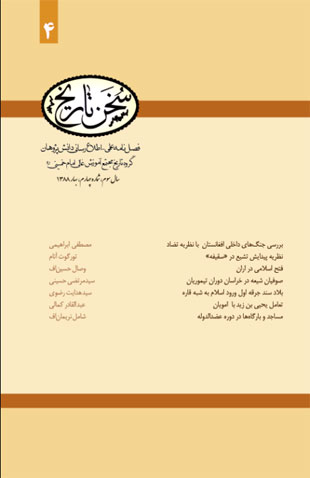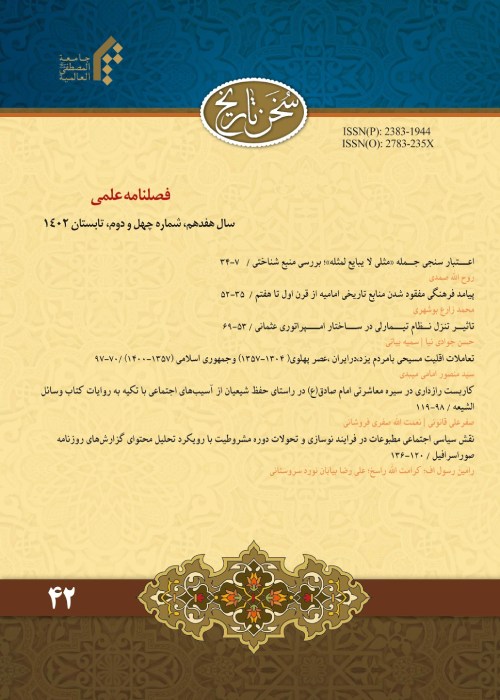فهرست مطالب

نشریه سخن تاریخ
پیاپی 4 (بهار 1388)
- بهای روی جلد: 15,000ريال
- تاریخ انتشار: 1388/04/20
- تعداد عناوین: 9
-
صفحه 23
-
صفحه 47
-
صفحه 85
-
صفحه 103
-
صفحه 121
-
چکیده مقالات به زبان انگلیسیصفحه 124
-
Page 3The civil wars of Afghanistan are the result of the interest and powercontradiction amongst the organizations and sociopolitical groups. Theresidents of this territory holding somehow inconsistent identity caused thatan incompatible human geography should also come to existence. Hence, it entailed other racial, tribal, religious, and linguistic conflicts in the social life of them. The discrimination and injustice led by the dominant authorities over other nations being deprived of their socio-political, socio-cultural and economical rights for safeguarding their own power from one hand; and the revival of socio-political insight alongside development of selfconsciousness of the socio-political factions of the deprived nations fromanother hand, enhanced the existent conflicts in highest possible level. Ultimately, it ended up to a lengthy civil war amongst the existent groups in Afghanistan.
-
Page 23The historians and intellectuals have put forward variety of opinions with respect to genesis of Shiism. From amongst the theories, two of them are exclusive of the Shiite intellectuals. The first of them maintains that the shiism came into existence at the lifetime of noble Prophet (peace be upon him and his households) whereas the second notion traces its emergence to the event of Saqifah. However, some of the Sunni scholars and orient a lists have chosen the second approach.After the demise of the Prophet, a group of Ansar alongside some immigrants joining them later, assembled in Saqifa Bani Saaedah to select and determine his vicegerent. Finally, it was Abubakr who was chosen as the first caliph for the Muslims. Meanwhile, a particular group being the partisan to Ali criticized the selection and never agreed his being as Muslims caliph.This faction having particular motives prompted a movement which gradually got developed. So, the major concern here is not the word of Shia rather the main dispute lays in existence or non existence of such a movement, irrespective of its name, quantity or its social manifestation. It is believed that there exist abundant amount of historical documents proving such a movement explicitly in the course of history
-
Page 47Aran or the historical Albania was counted a region located in south western of Asia and on the south of Caucasus, which its todays geographical boundary include Azerbaijan (except the southern Islands of Aras river), the north of self autonomous republic of Dagestan and some eastern parts of Armenia and Georgia.Aran at the advent was a semi-independent country paying regular taxes and tributes to Sassanian Empire. This territory has partly been conquered by Muslims in 22 A.H. and entirely on 24th of A.H. the first phase of victories was by the order of Umar Bin Khattab and the second phase was by the order of Uthman Bin Affan. The victories over the entire regions and cities came along without facing a single war and the Muslims took taxes for guaranteeing the security of their properties and territory. Preparing thebackgrounds for propagation of the religion of Islam and conveying the monotheist call to the mass and taking the ways from the north was the two important factors of the conquering of Aran. After conquering of Aran, Islam started to develop as much that at the end of Omayyad reign Islam alongside Christianity became the two major andsignificant religions of the people. The reasons behind the development of Islam in Aran should be sought in its just, humanitarian and truth seeking spirit of its instructions. Where in this religion the Arab and non Arab, slave and free, and rich and poor enjoy an equal right
-
Page 56In todays geographical sphere of Afghanistan which has previously been known as Khorasan, at the time of the Timurid (771-911 A.H) there have lived three important factions of Shiite Sufis. These three Sufi factions came into existence and then developed in the very period. The first of these ways is called Namatullahi that has been pioneered by Shah Naamatullah Wali. The 2nd way is called Horofiah that has been pioneered by Fazlullah Estarabadi whose adherents attempted to murder Shahruhkhan Timori in Hirat. The 3rd group is called Noorbakhshiyah, being established by SayyedNoorbakhsh. His presence and influence was tangible in the Islamic territories on that period.
-
Page 72Sindh valley being a suitable channel for entrance of Islam in Indian subcontinent is one of the oldest civilizations of the world. The vestiges chieved from excavated site of Sindh valley called Mohenjo Daro, reflect that the resident of that valley had an advanced way of life. After a short period from the demise of the noble Prophet, Islam has just reached the borders of Indian sub content.In late Imam Alis caliphate reign on the year of 38 A.h (757 A.D.) Harith Bin Marrah Abdi, voluntarily by the permission of Ali went towards the Indian borders and achieved victories. On the year of 92 A.H (712 A.D) Muhammad Bin Qasem after dominance over sindh, protected the lives and properties of the dwellers and did not shed their blood. It is tried to have a glance at all these topics in the present writing
-
Page 85After the defeat of Zaid bin Alis movement by Omayyad, Yahiya bin Zaid did not see the Iraqs situation proper enough for continuation of his and his fathers revolutionary way. Hence, with the suggestion of his advocates and for the following up the purposes of Zaids movement, he made a secret trip towards Khorasan without being noticed by Umayyad spies. In this historical migration variety of episodes and instances occurred, that worth to be studied with profundity. The very writing firstly meets the events took placeduring his historical migration and then describes his interaction with Umayyad authorities. Moreover, the factors will be revised which ended to a tension in relation between Alawiyan and Omayyades.
-
Page 103With the emergence of Islam in Arab peninsula, the divine house Allah was counted as the first educational center of Muslims. Afterwards, the Masque of the Prophets activity (Masjid-al-nabi) commenced. Then ordinary masques got altered to centers of multi-dimensional activities of the Muslims. Their important tasks of judicial cases and educational issues found their ways of solution in the masques. These are counted as earliest activities of the masques on the advent of Islam. Nevertheless, the highlyincreasing number of people seeking knowledge and for the sake of avoiding nuisance for the worshippers, the Muslims changed their place of learning. On the fourth century of A.H., the different names of these places are recorded in the historical resources. In Islam, education and instruction has not been restricted in a place rather has had variety of stages. The Muslim states in every era and epoch have always been encouraging of one another in establishment of educational sites. Azad-al-dowlah being an influentialmonarch of Al-e-Buyah has led some historically important constructive proceedings in 4th A.H century. Some of his leftover building effects still attract the attention of the tourists. The very article is intent to have a survey of his proceedings in construction of courts and masques which at that time had an effective role in development of Islamic civilization.


